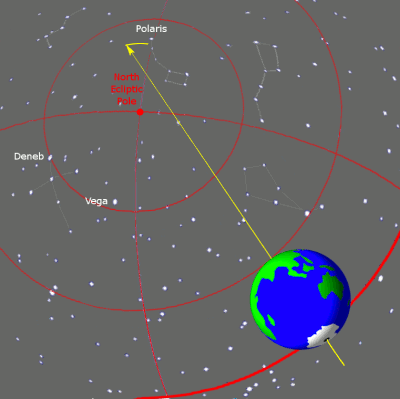
Caption: An animation illustrating the axial precession of the Earth's axis.
The axial precession causes a westward or clockwise circular rotation of the north celestial pole (NCP) on the celestial sphere as seen from outside the celestial sphere looking down on the NCP.
In the animation, we are looking upward toward the north celestial pole (NCP), and so the axial precession is eastward or counterclockwise.
Features:
- The
axial precession
is caused by the
Earth's axial rotation
in combination with
the tidal force
(in order decreasing importance)
the Moon,
the Sun,
and, to a much lesser degree, the other
Solar-System bodies
on the Earth's
equatorial bulge
(see Wikipedia: Axial precession: Cause)
which are in turn caused by the
Earth's axial rotation.
- The rate of
axial precession
varies with time due various
astronomical perturbations
(see Wikipedia:
Axial precession: Values).
The astronomical perturbations
(including those due to the slow chaotic
evolution of the Solar System)
are mainly due
gravitational perturbations
and somewhat due to the somewhat
chaotic
internal motions of the
Earth
caused by plate tectonics
and other processes driven by
primordial-radiogenic heat geology.
The astronomical perturbations make it impossible to predict the exact rate beyond a few thousand years to the past or the future (Wikipedia: Axial precession: Values).
If the current rate is taken as constant, the period would be 25,771.5 Julian years (Jyr) ≅ 26000 Julian years (Jyr) (see Wikipedia: Axial precession: Values). A Julian year is exactly 365.25 days.
However, from elaborate calculations the actual period is thought to be ∼ 41000 Julian years (Jyr) (see Wikipedia: Axial precession: Values).
However again, due to the astronomical perturbations, the period of axial precession will NEVER be exactly the same twice and over the long-term evolution of the Solar System the period will probably increase significantly (see Wikipedia: Axial precession: Values).
-
As you can see from the animation,
Polaris
(apparent V magnitude 1.98)
is only the
pole star of the
north
for awhile.
- In Greco-Roman antiquity,
the tail end of Ursa Minor
was recognized as useful in approximating the
NCP region, but
the NCP was
NOT strikingly close Polaris.
Stobaeus (fl. 5th century CE)
noted Polaris as a skymark of the
NCP region, but
the NCP
was then still 8° away from
Polaris.
In Middle Ages,
the NCP was noticeably closer
to Polaris
and Polaris was becoming more useful
in navigation as
the pole star.
However, even in
1547,
the NCP was still
3.8° from
Polaris and
Polaris was still only
rather approximately the
pole star of the
north
(see Wikipedia: Pole Star: History).
- As of 2012 October,
the NCP was
∼ 40 arcminutes
from Polaris.
- On
2100 Mar24,
the NCP
will make its closest apparent approach of
∼ 27 arcminutes
to Polaris
(see Wikipedia: Pole star: Precession of the equinoxes).
- Circa year 4000 CE,
NCP
will make its closest approach of ∼ 2° to
γ Cephei
(apparent V magnitude 3.22)
which will then lay a claim to being the
pole star of the
north.
- Circa year 10,000 CE,
NCP
will make its closest approach of ∼ 5° to
the bright star
Deneb
(apparent V magnitude 1.25)
which will then lay a claim to being the
pole star of the
north.
One wonders who will notice.
Image link: Wikipedia: File:Precession animation small new.gif.
Local file: local link: axial_precession_animation.html.
File: Celestial sphere file: axial_precession_animation.html.